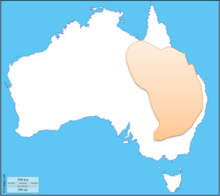Taunton National Park is situated near the town of Dingo approximately 135 km inland from Rockhampton in eastern Central Queensland, Australia. The park encompasses an area of 11,626 ha within the Northern Brigalow Belt bioregion of Queensland; a region widely recognised to contain considerable biodiversity.

The black currawong, also known locally as the black jay, is a large passerine bird endemic to Tasmania and the nearby islands within the Bass Strait. One of three currawong species in the genus Strepera, it is closely related to the butcherbirds and Australian magpie within the family Artamidae. It is a large crow-like bird, around 50 cm (20 in) long on average, with yellow irises, a heavy bill, and black plumage with white wing patches. The male and female are similar in appearance. Three subspecies are recognised, one of which, Strepera fuliginosa colei of King Island, is vulnerable to extinction.

Bowerbirds make up the bird family Ptilonorhynchidae. They are renowned for their unique courtship behaviour, where males build a structure and decorate it with sticks and brightly coloured objects in an attempt to attract a mate.

The great bowerbird is a common and conspicuous resident of northern Australia, from the area around Broome across the Top End to Cape York Peninsula and as far south as Mount Isa. Favoured habitat is a broad range of forest and woodland, and the margins of vine forests, monsoon forest, and mangrove swamps.

The satin bowerbird is a bowerbird endemic to eastern Australia.

The pied butcherbird is a songbird native to Australia. Described by John Gould in 1837, it is a black and white bird 28 to 32 cm long with a long hooked bill. Its head and throat are black, making a distinctive hood; the mantle and much of the tail and wings are also black. The neck, underparts and outer wing feathers are white. The juvenile and immature birds are predominantly brown and white. As they mature their brown feathers are replaced by black feathers. There are two recognised subspecies of pied butcherbird.

The white-plumed honeyeater is a small passerine bird endemic to Australia. White-plumed honeyeaters are common around water and are often seen in backyards and suburbs with vegetation cover.
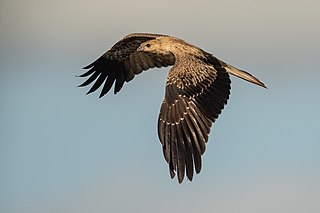
The whistling kite is a medium-sized diurnal raptor found throughout Australia, New Caledonia and much of New Guinea. Also called the whistling eagle or whistling hawk, it is named for its loud whistling call, which it often gives in flight. Some authorities put this species in the genus Milvus, despite marked differences in behaviour, voice and plumage between this species and other members of that genus.

The topknot pigeon is a pigeon native to eastern Australia.
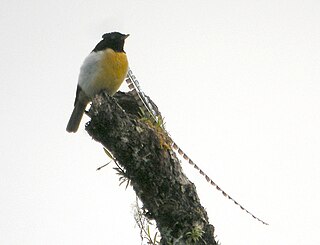
The King of Saxony bird-of-paradise is a bird in the bird-of-paradise family (Paradisaeidae). It is the only member of the genus Pteridophora. It is endemic to montane forest in New Guinea.

The superb lyrebird is an Australian passerine songbird, one of two species from the family Menuridae, with the other being the much rarer Albert's lyrebird. It is one of the world's largest songbirds, and is renowned for its elaborate tail and courtship displays, and its excellent mimicry. The species is endemic to Australia and is found in forest in the southeast of the country. According to David Attenborough, the superb lyrebird displays one of the most sophisticated voice skills within the animal kingdom—"the most elaborate, the most complex, and the most beautiful".

The golden bowerbird is a species of bird in the family Ptilonorhynchidae, the bowerbirds. It is endemic to Queensland in Australia, where it is limited to the Atherton region.

The spotted catbird is a species of bowerbird (Ptilonorhynchidae) which can be found in north Queensland, the eastern Moluccas and New Guinea. Although it is a member of the bowerbird family it does not build a bower.

The regent bowerbird is a medium-sized, up to 25 cm long, sexually dimorphic bowerbird. The male bird is black with a golden orange-yellow crown, mantle and black-tipped wing feathers. It has yellow bill, black feet and yellow iris. The female is a brown bird with whitish or fawn markings, grey bill, black feet and crown. The name commemorates a prince regent of the United Kingdom.

MacGregor's bowerbird is a medium-sized, up to 26 cm long, olive brown bowerbird of New Guinea's mountain forests, roughly the size and shape of an American Robin or a Eurasian Blackbird. The male is adorned with an erectile orange yellow crest, that is partly hidden until shown in courtship display. The unadorned female is similar to the male, but without the crest. Superb mimics, they are known for imitating other birds, pigs, rushing water, and even human speech.

The genus Ptiloris consists of four allopatric species of birds in the family Paradisaeidae. These birds of paradise are commonly known as riflebirds, so named for the likeness of their black velvety plumage to the uniform of the Rifle Brigade. Alternatively, the bird's cry is similar to a rifle being fired and hitting its target but a call like this is not commonly reported. They are distributed in the rainforests of New Guinea and Eastern Australia.

The fawn-breasted bowerbird is a medium-sized, up to 32 cm (13 in) long, bowerbird with a greyish brown spotted white plumage, a black bill, dark brown iris, yellow mouth and an orange buff below. Both sexes are similar. The female is slightly smaller than the male.
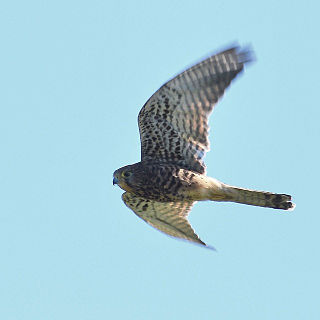
The spotted kestrel is also known as the Moluccan kestrel.
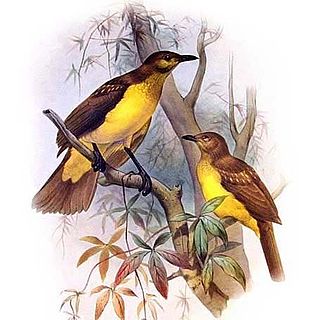
The yellow-breasted bowerbird also known as Lauterbach's bowerbird, is a medium-sized, approximately 27 cm long, bowerbird with a brownish-olive upperparts plumage, grayish-yellow upper breast, coppery crown, dark brown iris, yellow underparts, a black bill and pinkish-orange mouth. Both sexes are similar. The female exhibits less vibrant coloration than the male.

The western bowerbird is a species of bird in the family Ptilonorhynchidae. The species is a common endemic of Australia. It has a disjunct distribution, occurring in Central Australia and the Pilbara region of Western Australia.

